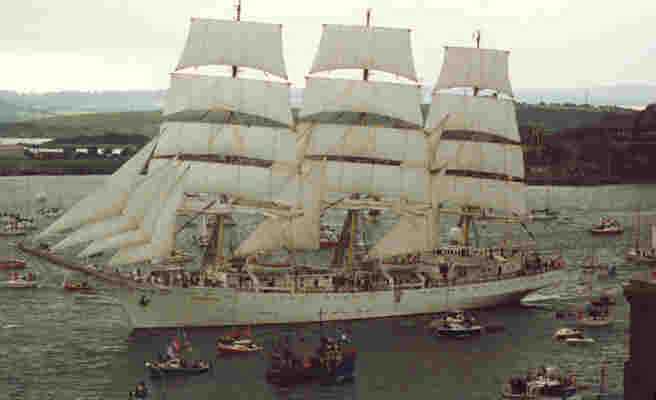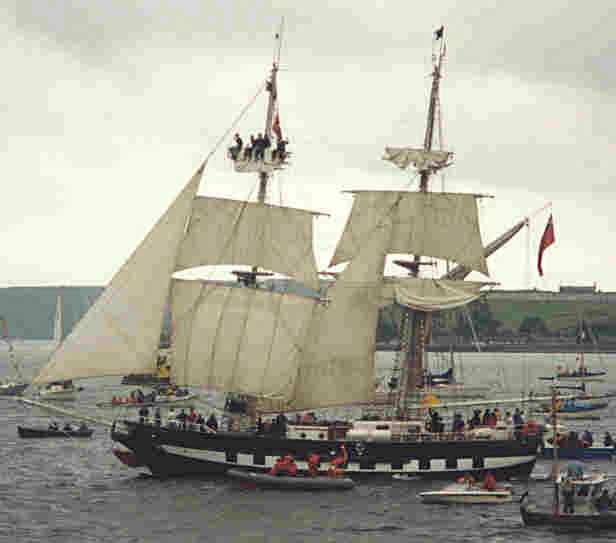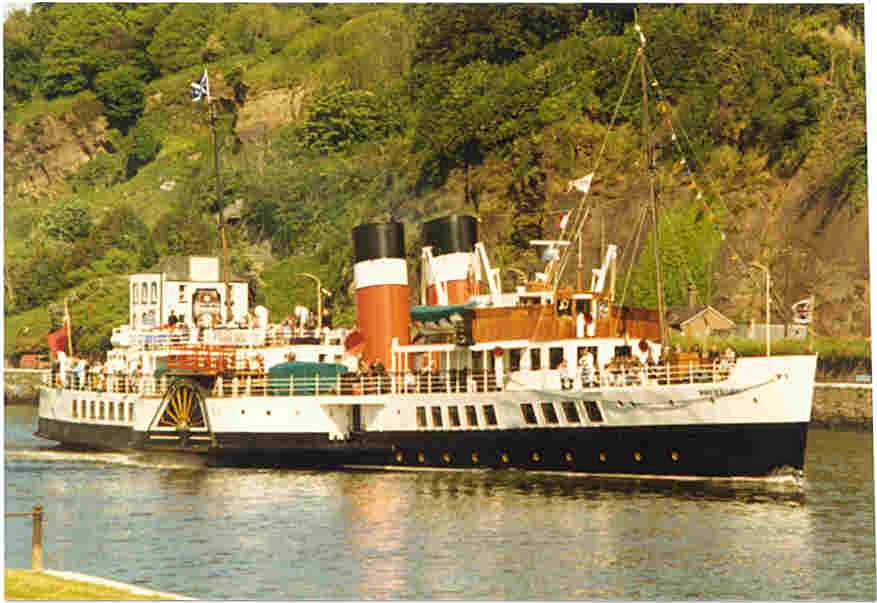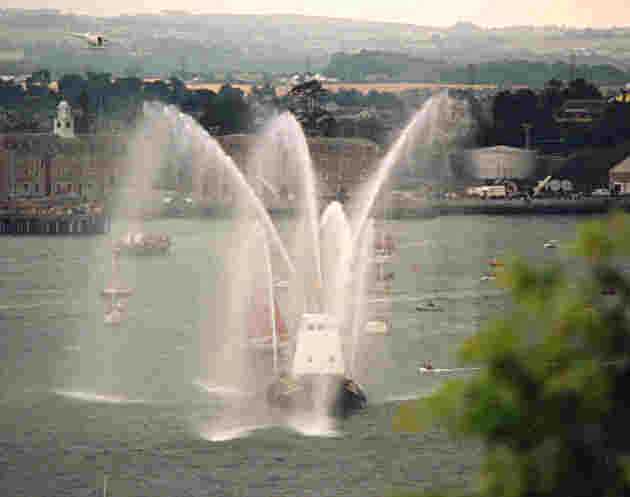 Cork
has one of the largest harbours in Europe and has a long history of international
trade. Excavations of ringforts in the county have revealed objects from
the eastern mediterranean, eg. the amphorae at Garranes ring fort. Certainly
the area was visited by the vikings and with them came improved shipbuilding
techniques. By the 13th and 14th century a great deal of imported pottery
was in use within the walls of Cork city. This pottery points to trade
links with south western France as well as with England. In particular
the port of Bristol was much frequented by ships from Cork. Wine from Bordeaux
was a popular import at this time. Both sea and river fishing Cork
has one of the largest harbours in Europe and has a long history of international
trade. Excavations of ringforts in the county have revealed objects from
the eastern mediterranean, eg. the amphorae at Garranes ring fort. Certainly
the area was visited by the vikings and with them came improved shipbuilding
techniques. By the 13th and 14th century a great deal of imported pottery
was in use within the walls of Cork city. This pottery points to trade
links with south western France as well as with England. In particular
the port of Bristol was much frequented by ships from Cork. Wine from Bordeaux
was a popular import at this time. Both sea and river fishing were well established. In the 18th and 19th centuries the main exports
were meat and butter. According to an account of 1688, 10,000 cattle were
being slaughtered each year and then exported to other European ports and
to the West Indies. By 1750 this figure had risen to 1000,000 cattle. In
1633 a method to barrel butter so that it could travel successfully was
developed. The butter market was established on the north side of the city.
By 1770 this market was exporting approximately 109,367 barrels annually.
The tradition of shipbuilding was also strong in the Cork area. Small fishing
vessels were often built at the small harbours from which they worked.
Larger yards were established at Cork, Youghal and Kinsale. The largest
yards came to be concentrated around Cork harbour. The most important of
these was establised at Rushbrooke. The British Admiralty established a
victualling base on Haulbowline Island in Cork harbour. A large dry dock
was added to this base in 1887. Today this island is the main base of the
Irish navy. Kinsale and Bantry Bay also served as British naval bases.
The 1800's saw the growth of emigration, particularly during the famine
years. For many of these emigrants their last sight
were well established. In the 18th and 19th centuries the main exports
were meat and butter. According to an account of 1688, 10,000 cattle were
being slaughtered each year and then exported to other European ports and
to the West Indies. By 1750 this figure had risen to 1000,000 cattle. In
1633 a method to barrel butter so that it could travel successfully was
developed. The butter market was established on the north side of the city.
By 1770 this market was exporting approximately 109,367 barrels annually.
The tradition of shipbuilding was also strong in the Cork area. Small fishing
vessels were often built at the small harbours from which they worked.
Larger yards were established at Cork, Youghal and Kinsale. The largest
yards came to be concentrated around Cork harbour. The most important of
these was establised at Rushbrooke. The British Admiralty established a
victualling base on Haulbowline Island in Cork harbour. A large dry dock
was added to this base in 1887. Today this island is the main base of the
Irish navy. Kinsale and Bantry Bay also served as British naval bases.
The 1800's saw the growth of emigration, particularly during the famine
years. For many of these emigrants their last sight  of
Ireland was the town of Queenstown, now Cobh. In particular the last passengers
to board "Titanic" on her tragic maiden voyage were brought by tender from
Queenstown to Roches Point where the great ship had laid anchor. Many of
the victims of the "Lusitania" were brought ashore at Queenstown where
they were buried in the old church graveyard. Most of the remaining victims
were brought to Kinsale, where the first inquest on the sinking was held
by the coroner, John Horgan. In 1821 the St. George Steam Packet Company
was established. It began trading on the Cork to Bristol run but soon added
new routes. The company offices can still be seen on Penrose Quay in the
city. This company owned
the "Sirius" which became the first steamboat to cross the atlantic beating
Brunel's "Great Western" by less than 24 hours. The "Sirius"departed from
London on 28th March 1838 with a crew of 38 and 40 passengers. She made
a brief stopover at Passage West to take on additional supplies of coal
and arrived into New York on 22nd April 1838. The ships captain, Richard
Roberts, who was born in Passage West in 1803 was made a freeman of Cork
city on his return from the trium of
Ireland was the town of Queenstown, now Cobh. In particular the last passengers
to board "Titanic" on her tragic maiden voyage were brought by tender from
Queenstown to Roches Point where the great ship had laid anchor. Many of
the victims of the "Lusitania" were brought ashore at Queenstown where
they were buried in the old church graveyard. Most of the remaining victims
were brought to Kinsale, where the first inquest on the sinking was held
by the coroner, John Horgan. In 1821 the St. George Steam Packet Company
was established. It began trading on the Cork to Bristol run but soon added
new routes. The company offices can still be seen on Penrose Quay in the
city. This company owned
the "Sirius" which became the first steamboat to cross the atlantic beating
Brunel's "Great Western" by less than 24 hours. The "Sirius"departed from
London on 28th March 1838 with a crew of 38 and 40 passengers. She made
a brief stopover at Passage West to take on additional supplies of coal
and arrived into New York on 22nd April 1838. The ships captain, Richard
Roberts, who was born in Passage West in 1803 was made a freeman of Cork
city on his return from the trium phant voyage. In January 1847 the "Sirius"
was heading into Cork in thick fog when she ran against high cliffs, her
crew tried to bring her on to Cork but she foundered on a reef of rock
jutting out from the cliffs of Ballycotton. The ships main shaft can now
be seen in Passage West. The Clyde Shipping Company
also operated out of Cork. Their ships travelled from Cork to Glasgow,
from 1859 to 1962, with stops at Waterford and Dublin. More recent developments
in Cork harbour include the Tivoli Industrial Estate, which was completed
in 1976 on reclaimed land and has roll-on roll-off and container facilities,
the creation of Irelands first Free port at Ringaskiddy in 1984 and the
deep water berth at Ringaskiddy opened in 1990. The Queen Elizabeth II
visited Ringaskiddy in 1988 in order to celebrate the 150th anniversary
of the "Sirius" voyage and the Cutty Sark tall ships race visited Cork
in 1991. phant voyage. In January 1847 the "Sirius"
was heading into Cork in thick fog when she ran against high cliffs, her
crew tried to bring her on to Cork but she foundered on a reef of rock
jutting out from the cliffs of Ballycotton. The ships main shaft can now
be seen in Passage West. The Clyde Shipping Company
also operated out of Cork. Their ships travelled from Cork to Glasgow,
from 1859 to 1962, with stops at Waterford and Dublin. More recent developments
in Cork harbour include the Tivoli Industrial Estate, which was completed
in 1976 on reclaimed land and has roll-on roll-off and container facilities,
the creation of Irelands first Free port at Ringaskiddy in 1984 and the
deep water berth at Ringaskiddy opened in 1990. The Queen Elizabeth II
visited Ringaskiddy in 1988 in order to celebrate the 150th anniversary
of the "Sirius" voyage and the Cutty Sark tall ships race visited Cork
in 1991. |

 Cork
has one of the largest harbours in Europe and has a long history of international
trade. Excavations of ringforts in the county have revealed objects from
the eastern mediterranean, eg. the amphorae at Garranes ring fort. Certainly
the area was visited by the vikings and with them came improved shipbuilding
techniques. By the 13th and 14th century a great deal of imported pottery
was in use within the walls of Cork city. This pottery points to trade
links with south western France as well as with England. In particular
the port of Bristol was much frequented by ships from Cork. Wine from Bordeaux
was a popular import at this time. Both sea and river fishing
Cork
has one of the largest harbours in Europe and has a long history of international
trade. Excavations of ringforts in the county have revealed objects from
the eastern mediterranean, eg. the amphorae at Garranes ring fort. Certainly
the area was visited by the vikings and with them came improved shipbuilding
techniques. By the 13th and 14th century a great deal of imported pottery
was in use within the walls of Cork city. This pottery points to trade
links with south western France as well as with England. In particular
the port of Bristol was much frequented by ships from Cork. Wine from Bordeaux
was a popular import at this time. Both sea and river fishing were well established. In the 18th and 19th centuries the main exports
were meat and butter. According to an account of 1688, 10,000 cattle were
being slaughtered each year and then exported to other European ports and
to the West Indies. By 1750 this figure had risen to 1000,000 cattle. In
1633 a method to barrel butter so that it could travel successfully was
developed. The butter market was established on the north side of the city.
By 1770 this market was exporting approximately 109,367 barrels annually.
The tradition of shipbuilding was also strong in the Cork area. Small fishing
vessels were often built at the small harbours from which they worked.
Larger yards were established at Cork, Youghal and Kinsale. The largest
yards came to be concentrated around Cork harbour. The most important of
these was establised at Rushbrooke. The British Admiralty established a
victualling base on Haulbowline Island in Cork harbour. A large dry dock
was added to this base in 1887. Today this island is the main base of the
Irish navy. Kinsale and Bantry Bay also served as British naval bases.
The 1800's saw the growth of emigration, particularly during the famine
years. For many of these emigrants their last sight
were well established. In the 18th and 19th centuries the main exports
were meat and butter. According to an account of 1688, 10,000 cattle were
being slaughtered each year and then exported to other European ports and
to the West Indies. By 1750 this figure had risen to 1000,000 cattle. In
1633 a method to barrel butter so that it could travel successfully was
developed. The butter market was established on the north side of the city.
By 1770 this market was exporting approximately 109,367 barrels annually.
The tradition of shipbuilding was also strong in the Cork area. Small fishing
vessels were often built at the small harbours from which they worked.
Larger yards were established at Cork, Youghal and Kinsale. The largest
yards came to be concentrated around Cork harbour. The most important of
these was establised at Rushbrooke. The British Admiralty established a
victualling base on Haulbowline Island in Cork harbour. A large dry dock
was added to this base in 1887. Today this island is the main base of the
Irish navy. Kinsale and Bantry Bay also served as British naval bases.
The 1800's saw the growth of emigration, particularly during the famine
years. For many of these emigrants their last sight  of
Ireland was the town of Queenstown, now Cobh. In particular the last passengers
to board "Titanic" on her tragic maiden voyage were brought by tender from
Queenstown to Roches Point where the great ship had laid anchor. Many of
the victims of the "Lusitania" were brought ashore at Queenstown where
they were buried in the old church graveyard. Most of the remaining victims
were brought to Kinsale, where the first inquest on the sinking was held
by the coroner, John Horgan. In 1821 the St. George Steam Packet Company
was established. It began trading on the Cork to Bristol run but soon added
new routes. The company offices can still be seen on Penrose Quay in the
city. This company owned
the "Sirius" which became the first steamboat to cross the atlantic beating
Brunel's "Great Western" by less than 24 hours. The "Sirius"departed from
London on 28th March 1838 with a crew of 38 and 40 passengers. She made
a brief stopover at Passage West to take on additional supplies of coal
and arrived into New York on 22nd April 1838. The ships captain, Richard
Roberts, who was born in Passage West in 1803 was made a freeman of Cork
city on his return from the trium
of
Ireland was the town of Queenstown, now Cobh. In particular the last passengers
to board "Titanic" on her tragic maiden voyage were brought by tender from
Queenstown to Roches Point where the great ship had laid anchor. Many of
the victims of the "Lusitania" were brought ashore at Queenstown where
they were buried in the old church graveyard. Most of the remaining victims
were brought to Kinsale, where the first inquest on the sinking was held
by the coroner, John Horgan. In 1821 the St. George Steam Packet Company
was established. It began trading on the Cork to Bristol run but soon added
new routes. The company offices can still be seen on Penrose Quay in the
city. This company owned
the "Sirius" which became the first steamboat to cross the atlantic beating
Brunel's "Great Western" by less than 24 hours. The "Sirius"departed from
London on 28th March 1838 with a crew of 38 and 40 passengers. She made
a brief stopover at Passage West to take on additional supplies of coal
and arrived into New York on 22nd April 1838. The ships captain, Richard
Roberts, who was born in Passage West in 1803 was made a freeman of Cork
city on his return from the trium phant voyage. In January 1847 the "Sirius"
was heading into Cork in thick fog when she ran against high cliffs, her
crew tried to bring her on to Cork but she foundered on a reef of rock
jutting out from the cliffs of Ballycotton. The ships main shaft can now
be seen in Passage West. The Clyde Shipping Company
also operated out of Cork. Their ships travelled from Cork to Glasgow,
from 1859 to 1962, with stops at Waterford and Dublin. More recent developments
in Cork harbour include the Tivoli Industrial Estate, which was completed
in 1976 on reclaimed land and has roll-on roll-off and container facilities,
the creation of Irelands first Free port at Ringaskiddy in 1984 and the
deep water berth at Ringaskiddy opened in 1990. The Queen Elizabeth II
visited Ringaskiddy in 1988 in order to celebrate the 150th anniversary
of the "Sirius" voyage and the Cutty Sark tall ships race visited Cork
in 1991.
phant voyage. In January 1847 the "Sirius"
was heading into Cork in thick fog when she ran against high cliffs, her
crew tried to bring her on to Cork but she foundered on a reef of rock
jutting out from the cliffs of Ballycotton. The ships main shaft can now
be seen in Passage West. The Clyde Shipping Company
also operated out of Cork. Their ships travelled from Cork to Glasgow,
from 1859 to 1962, with stops at Waterford and Dublin. More recent developments
in Cork harbour include the Tivoli Industrial Estate, which was completed
in 1976 on reclaimed land and has roll-on roll-off and container facilities,
the creation of Irelands first Free port at Ringaskiddy in 1984 and the
deep water berth at Ringaskiddy opened in 1990. The Queen Elizabeth II
visited Ringaskiddy in 1988 in order to celebrate the 150th anniversary
of the "Sirius" voyage and the Cutty Sark tall ships race visited Cork
in 1991.